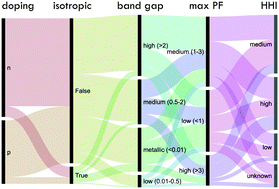Understanding thermoelectric properties from high-throughput calculations: trends, insights, and comparisons with experiment†
Abstract
We present an overview and preliminary analysis of computed thermoelectric properties for more than 48 000 inorganic compounds from the Materials Project (MP). We compare our calculations with available experimental data to evaluate the accuracy of different approximations in predicting thermoelectric properties. We observe fair agreement between experiment and computation for the maximum Seebeck coefficient determined with MP band structures and the BoltzTraP code under a constant relaxation time approximation (R2 = 0.79). We additionally find that scissoring the band gap to the experimental value improves the agreement. We find that power factors calculated with a constant and universal relaxation time approximation show much poorer agreement with experiment (R2 = 0.33). We test two minimum thermal conductivity models (Clarke and Cahill–Pohl), finding that both these models reproduce measured values fairly accurately (R2 = 0.82) using parameters obtained from computation. Additionally, we analyze this data set to gain broad insights into the effects of chemistry, crystal structure, and electronic structure on thermoelectric properties. For example, our computations indicate that oxide band structures tend to produce lower power factors than those of sulfides, selenides, and tellurides, even under the same doping and relaxation time constraints. We also list families of compounds identified to possess high valley degeneracies. Finally, we present a clustering analysis of our results. We expect that these studies should help guide and assess future high-throughput computational screening studies of thermoelectric materials.

- This article is part of the themed collection: The Chemistry of Thermoelectric Materials


 Please wait while we load your content...
Please wait while we load your content...